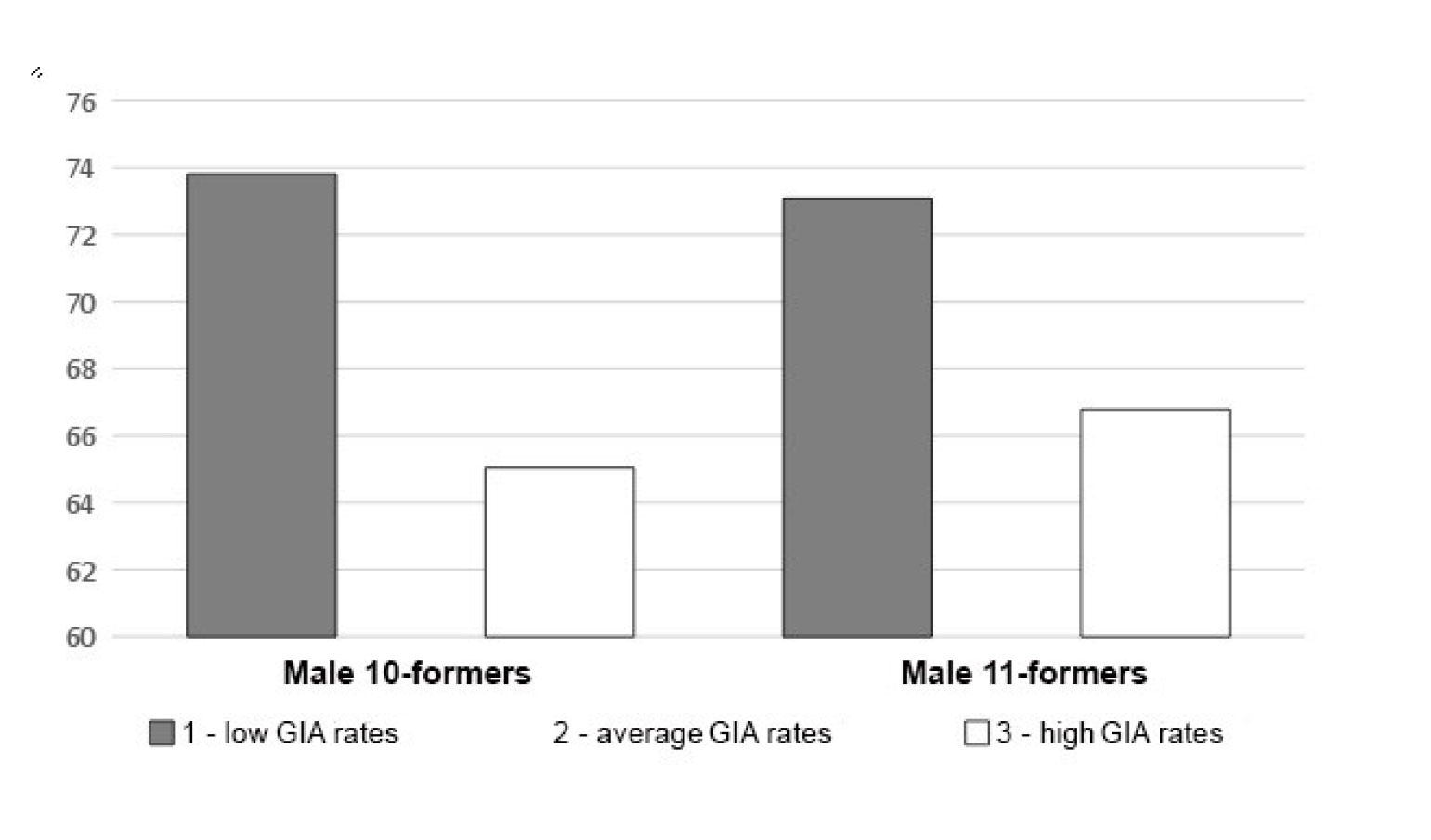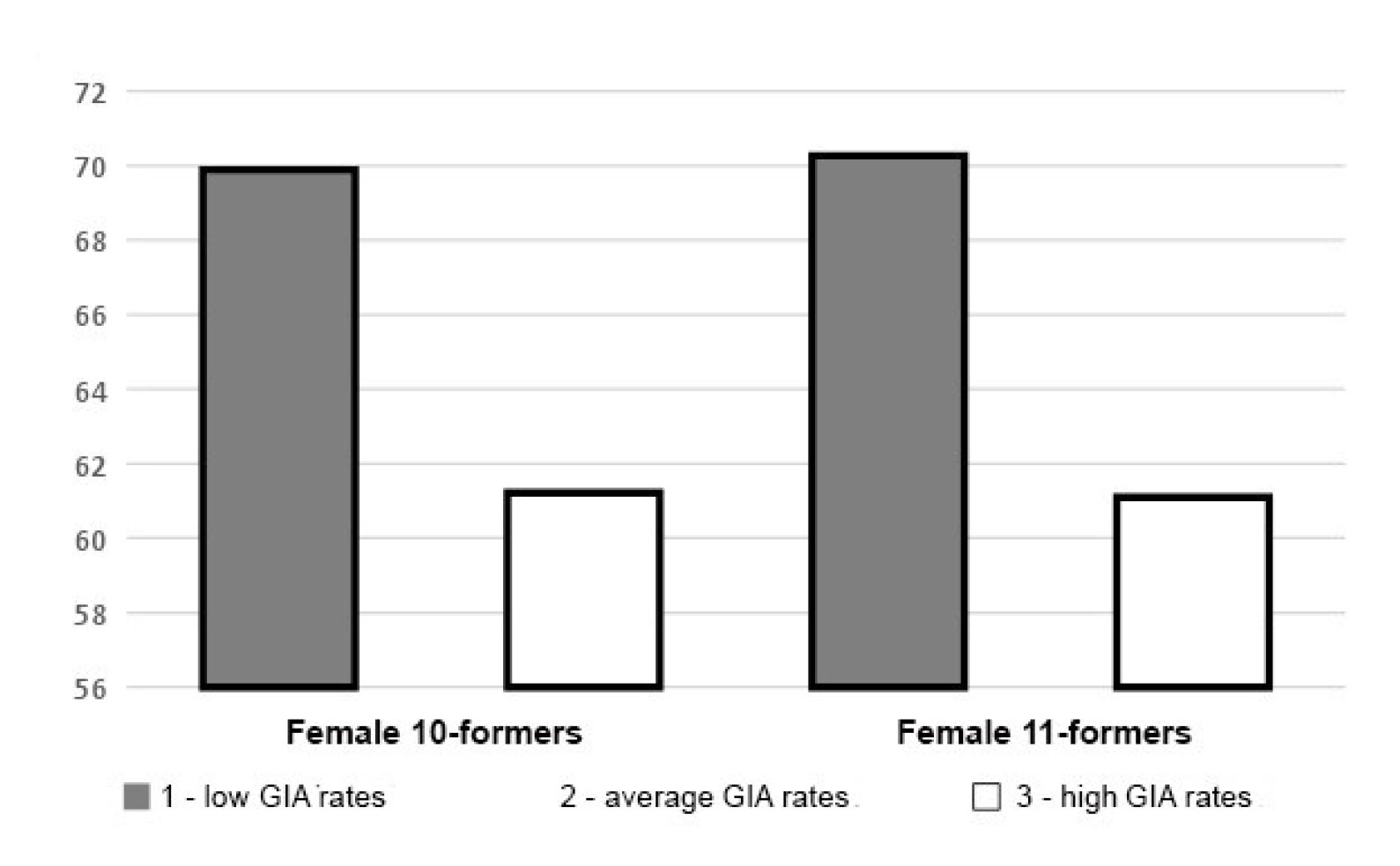Individual variations of age-specific motor qualities and motivations in 10-11-formers
Фотографии:
ˑ:
PhD, Associate Professor E.M. Revenko1
1Siberian State Automobile and Highway Academy (SibADI), Omsk
Keywords: motor abilities, general intellectual ability, individual age development specifics, motivations for motor activity.
Introduction. Currently, the level of motor activity of modern children and young people is low and insufficient for their health formation and maintenance. According to experts from different scientific fields, this circumstance is the main risk factor of public health. This situation is mainly due to the low attractiveness of the traditional physical education system, which does not solve one of the most important tasks - formation of stable motivations for physical activities, including self-reliant physical training. As a result, attendance of physical education classes keeps declining [1, 2]. Against this background, the situation is even more aggravated by the fact that self-training is excluded from the daily regimen of the vast majority of young people [5].
At the same time, in search of the innovative technologies to organize the physical education process, researchers often shift their attention to the outer (organizational) side of the question. It does make sense, however, a stable positive result cannot be achieved if individuality, individual age development specifics of children, adolescents and young people are not in the highlight when developing innovative methods and forms of organization of physical education classes [4].
Objective of the study was to determine the level of motivations for motor activity in schoolchildren with individual age development specifics.
Methods and organization of the study. The study conducted in 2016/2017 involved the 10- (53 boys and 28 girls) and 11-formers (69 boys and 33 girls) of the lyceum No. 149, Omsk, Russia (n=183).
The schoolchildren’s motor abilities were studied by measuring: strength (handgrip and torso dynamometry), strength endurance (boys: pull-ups, girls: push-ups), speed-strength ability (standing long jump), speed ability (100 m run, 3x10 m shuttle run) and overall endurance (1000 m run). The level of development of their general intelligence (GI) was assessed using R. Amthauer’s Intelligence Structure Test modified by L.A. Yasyukova [6]. Motivations for motor activity were evaluated using an author's questionnaire.
Results and discussion. The study of the correlation relationships between motor abilities and GI revealed a number of significant relations. Thus, the male 10-formers’ strength (handgrip and torso dynamometry) and strength endurance (pull-ups) negatively correlates at a statistically significant level with the level of development of GI (Table 1). In the male 11-formers, statistically significant relations were detected between the strength (handgrip and torso dynamometry) and speed (shuttle run) abilities and level of development of GI. At the same time, strength endurance of the 11-formers also negatively correlates with GI, but this relation is weak.
In general, as seen from Table 1, the male 10-11-formers demonstrated negative indices regardless of the intensity of correlation between motor abilities and GI rates. This indicates the split growth of the boys with predominance of either motor or intellectual functions.
Table 1. Correlations of motor manifestations and general intelligence (GI) level in male 10-11-formers
|
Motor manifestations |
Schoolchildren’s GIA rates |
|
|
10-formers |
11-formers |
|
|
Right handgrip strength test |
– 358** |
– 264* |
|
Left handgrip strength test |
– 391** |
– 259* |
|
Torso dynamometry |
– 279* |
– 244* |
|
Pull-ups |
– 306* |
– 216 |
|
Standing long jump |
– 214 |
– 204 |
|
3х10 m shuttle run |
– 194 |
– 268* |
|
100 m run |
– 134 |
– 188 |
|
1000 m run |
– 147 |
– 202 |
Note. Zero and points are dropped. Here and in Table. 2: sign * – reliability of differences (correlations) at the value level р ≤ 0.05; ** – р ≤ 0.01.
Due to the fact that the negative correlation with the run tests indices, measured by the time intervals (30 m run, 1000 m run, shuttle run), indicates a positive relation with the corresponding motor abilities (overall endurance, speed), the correlation sign in the correlation pleiades and in Tables 1 and 2 is changed to the opposite one. Therefore, the correlation with the indicators in the 100m, 1000 m, and shuttle run tests is to be deemed not as a temporal test index, but as a manifestation of the ability.
There are certain differences in the structure of the correlation pleiades in the female 10-11-formers as opposed to those in boys. In particular, the girls’ strength did not depend much on the level of development of GI, although it correlated with their strength endurance (Table 2). Moreover, the girls had statistically significant correlations between speed-strength, speed abilities and GI. The female 10-formers’ speed-strength ability (standing long jump) negatively correlates with GI at a statistically significant level, while in the female 11-formers this parameter negatively correlates at the statistically significant level with their speed ability (100 m run and shuttle run).
Basically, we can state that, as in the male samples, the female 10-11-formers demonstrated negative indices regardless of the intensity of correlation between motor abilities and GI.
Table 2. Correlations of motor manifestations and general intelligence (GI) in female 10-11-formers
|
Motor manifestations |
Schoolchildren’s GI rates |
|
|
10-formers |
11-formers |
|
|
Right hand carpal dynamometry |
– 213 |
– 185 |
|
Left hand carpal dynamometry |
– 267 |
– 148 |
|
Torso dynamometry |
– 140 |
– 292 |
|
Push-ups |
– 397* |
– 364* |
|
Standing long jump |
– 399* |
– 246 |
|
3х10 m shuttle run |
– 242 |
– 361* |
|
100 m run |
– 276 |
– 350* |
|
1000 m run |
– 121 |
– 091 |
Next, we analyzed the level of motivations for motor activity versus GI. The study found that the subjects with higher level of motivations for motor activity had lower GI rates but more pronounced manifestations of motor abilities, which was true in all examined samples, and vice versa. Thus, the male 10-formers with the lower GI rates had stronger motivations for motor activity than for those with the higher GI rates (73.81 versus 65.05, p≤0.01) (Fig. 1). Similar picture was observed among the male 11-formers (73.08 versus 66.77, p≤0.05).

Fig. 1. The level of motivations for motor activity in the male 10-11-formers with different levels of general intelligence
In the female 10-formers with the lower GI rates, motivations for motor activity were statistically significantly stronger than in the females with higher GI rates (69.89 versus 61.22; р≤0.05) (Fig. 2). Similar level of motivations, depending on GI, was found in the female 11-formers (70.27 versus 61.10, p≤0.05).

Fig. 2. The level of motivations for motor activity in the female 10-11-formers with different levels of general intelligence
The research findings indicated that in both male and female 10-11 formers their motor manifestations negatively correlated with GI. At the same time, general intelligence correlated significantly with strength and strength endurance in the boys, and with strength endurance, speed-strength and speed abilities - in the girls. Generally speaking, the overall correlation trend in all samples testifies to the split growth of adolescents with predominating motor or intellectual abilities. Stable and pronounced differences in the manifestations of the abilities in question testify to individual age development specifics.
The analysis of the level of motivations for motor activity in the 10-11-formers with different levels of GI revealed that both boys and girls with lower GI rates had stronger motivations for motor activity, and vice versa. Consequently, according to the correlations shown in Tables 1 and 2, senior pupils with a relatively low intelligence level but advancing in the development of their motor abilities have stronger motivations for motor activity, while schoolchildren with higher intelligence level but lagging motor abilities have statistically significantly weaker motivations.
Conclusion. The study data and analyses demonstrate the high practical need for the school physical education policies and practices being redesigned to step up their efficiency and form sustainable motivations in the rising generation for motor activity and self-reliant physical trainings.
The work was supported by the Russian Foundation for Humanities, project №16-16-55007, and Omsk Region Government.
References
- Vavilov Yu.N., Vavilov D.Yu. Sportivno-ozdorovitelnaya programma «Prezidentskie sostyazaniya» (avtorskiy proekt) [Sports and health program "Presidential competitions" (author's project)]. Teoriya i praktika fiz. kultury, 1997, no. 6, pp. 51–54.
- Pasek M., Mikhailowska-Sawchin M., Nowak-Zaleska A. Poseschaemost zanyatiy po fizicheskomu vospitaniyu i ee svyaz s otnosheniem k fizkulture i otdelnymi biologicheskimi i sotsialnymi faktorami s uchetom provedeniya zanyatiy v polevykh usloviyakh i shkolnykh zalakh [The Role of Physical Development and Specific Social Factors in Differentiation of Spirometric Characteristics of 12-13-Year-Old Children]. Teoriya i praktika fiz. kultury, 2014, no. 8, pp. 44–48.
- Revenko E.M., Salnikov V.A. Vzaimosvyazi dvigatelnykh i umstvennykh sposobnostey v protsesse vzrosleniya [Interrelationships of motor and mental abilities in growing up process]. Omsk: SibADI publ., 2014, 392 p.
- Salnikov V.A., Revenko E.M., Bebinov S.E. Individualnost lichnosti v sisteme innovatsionnogo fizicheskogo vospitaniya [Personal identity in innovative physical education system]. Obrazovanie i nauka. Izvestiya URO RAO, 2012, no. 8, pp. 124–135.
- Sinyavskiy N.I., Fursov A.V., Kizaev O.N., Gerega N.N. Soderzhanie nedelnoy dvigatelnoy aktivnosti studencheskoy molodezhi i ee samoanaliz [University students' weekly motor activity: content and introspection]. Fizicheskaya kultura: vospitanie, obrazovanie, trenirovka, 2016, no. 4, pp. 8–9.
- Yasyukova L.A. Test struktury intellekta R. Amthauera (IST). Metod. rukovodstvo [R. Amthauer intelligence structure test (IST). Method. guide]. St. Petersburg: IMATON publ., 2002, 80 p.
Corresponding author: revenko.76@mail.ru
Abstract
Experiment under the study was designed to profile the individual variations of the age-specific motor qualities, motivations and general intellectual abilities in 10-11 formers. The study data and analyses showed statistically significant negative correlations between motor qualities and general intelligence in the sample on the one hand; and on the other hand the study found differences in motivations for motor activity in students versus their intellectual abilities. The schoolchildren tested with higher physical development rates/ motor qualities and lower general intelligence showed higher motivation for motor activity. The study data and analyses demonstrate the practical need for the school physical education policies and practices to be redesigned to step up their efficiency and form sustainable motivations for motor activity and self-training.




